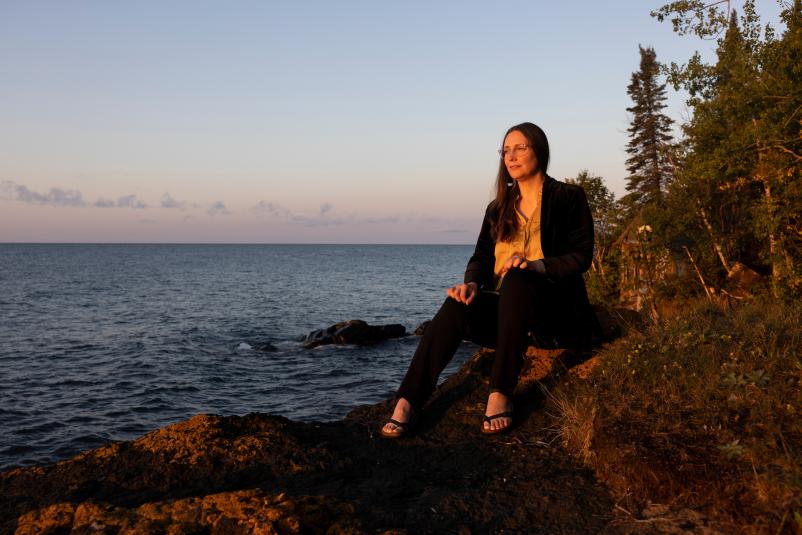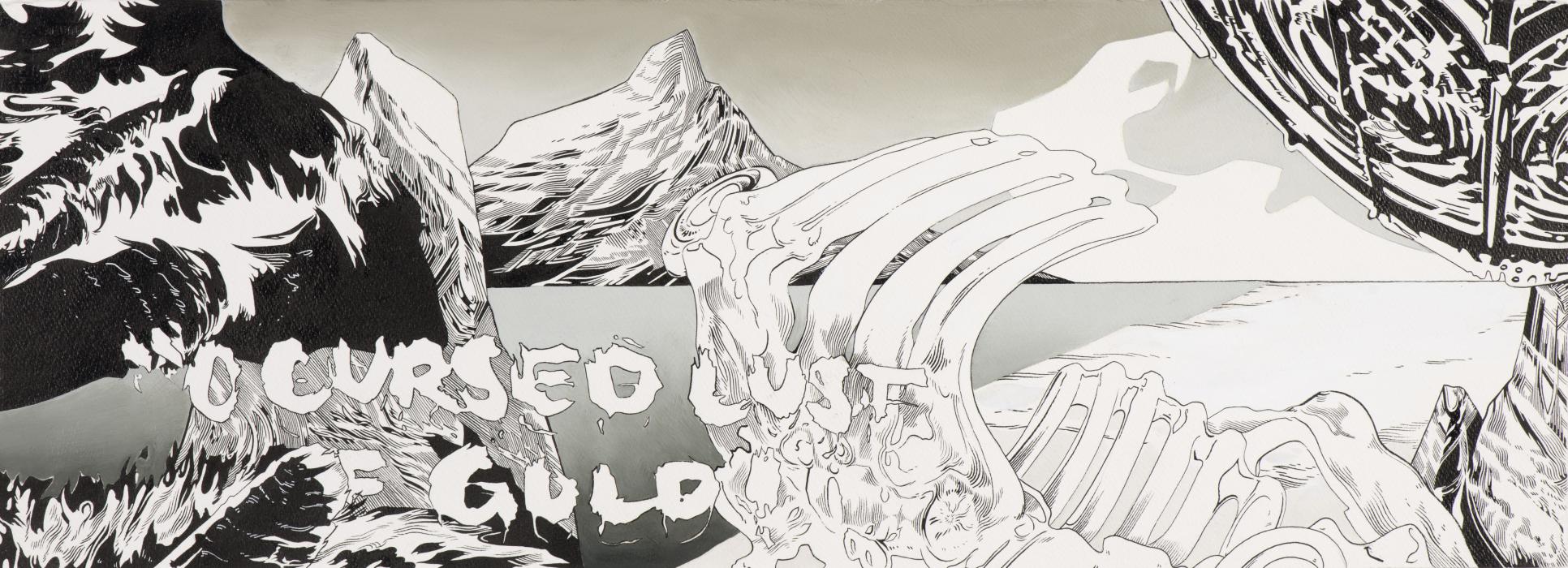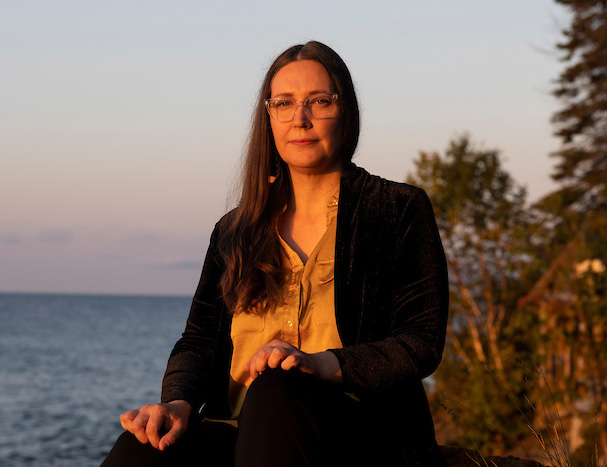Called Back: On George Morrison, Land Acknowledgement, and Returning Home

I recently had the pleasure of seeing a painting by George Morrison on display in a prominent museum in New York City. Although abstract, the work is filled with imagery familiar to anyone who’s seen the rock outcroppings on Gichi-gaming (Lake Superior). For me, Morrison’s work registers as a felt experience of a shared place. This is also true of the accompanying wall text. It offers his biographical data with the fewest strokes:
George Morrison
b. 1919 Chippewa City, Minnesota
d. 2000 Grand Marais, Minnesota
Such minimal context is an abstraction of an abstraction, an armature lacking recognizable features. Each line feels personal to me. There are origin stories and loss under these surface glints of information. George Morrison’s life and work had a profound impact on my own art career. Through the lines of the above wall text, I will attempt to pay homage to a man I admire through the things I carry, the things I remember and care for.
George Morrison’s Name
The wall text first states George Morrison’s name. His Ojibwe name is Waawaategonegaabo, Standing in the Northern Lights. This means that he is in the presence of his ancestors as they dance in the sky. In Ojibwemowin, the Ojibwe language, we attach the suffix “-iban” to names of the deceased. We believe that once someone has passed, we don’t say their unaltered name because their spirit may overhear and think we are calling them back. This suffix acknowledges a separation between the living and those whose spirits have traveled on.
Waawaategonegaabo-iban and George Morrison-iban might not accompany his work in a museum because that suffix might be just another thing that needs an explanation, another curiosity for the curious, a thing to be judged from the outside, and a tax on those who know. Perhaps these names are part of a grammar that wasn’t intended for the museum. Maybe these concepts should simply not be translated. Some things we believe are just for us or are respectfully reserved for those who know. Just as there is a reverence between the living and the dead, there should also be a reverence between the colonial and Indigenous space. There are unspoken protocols for each.
Born 1919
In 1919 George Morrison was born in Chippewa City, Minnesota, in a world wracked by a flu pandemic. In that same year, the jingle dress was given to the Ojibwe people to heal that sickness. In an exhibition marking 100 years of the jingle dress, Dr. Brenda Childs, a historian and professor at the University of Minnesota, documented the dress's creation during the 1918–20 Great Influenza Pandemic in the Mille Lacs Reservation area, about 230 miles southwest of Chippewa City. The jingle dress has a beautiful origin story. Around 1919 a distraught father whose daughter was sick with the Spanish flu had a persistent dream about the dress. The father implored women in their community to create the dress and dance. When his child witnessed the women dancing, she rose from her bed, became well, and started dancing with them. The 100th-anniversary celebration of the Jingle Dress, perhaps ironically, was impacted by the COVID-19 pandemic.
Today many contemporary artists—including Jeffery Gibson (Mississippi Band of Choctaw Indians/Cherokee Nation), Maria Hupfield (Ontario Ojibwe), Marie Watt (Seneca Nation of Indians), and Jason Wesaw (Pokagon Band of Potawatomi)—have taken up the essential materials used to make this dress: the rolled, cone-like jingle fashioned out of a tobacco can lid.
The dress arrived with its medicine the year Morrison was born. He came into a world that a dress was healing, and although it would take him time to develop his practice, he would also carry a form of healing that cracked artificial barriers.
Born in Chippewa City
George Morrison is Ojibwe, and he was born in what was then Chippewa City. Chippewa and Ojibwe are the same word. The early spelling of Ojibwe was Otchipwe, and in the 18th and 19th centuries, orthographies from various European languages confused the pronunciation. Chippewa became a common way to refer to Ojibwe people, but that is no longer the case. Many Ojibwe people now prefer the more inclusive word Anishinaabe.
In her 2019 book, Walking the Old Road: A People’s History of Chippewa City and the Grand Marais Anishinaabe, Ojibwe scholar Staci Drouillard outlines the history of Morrison’s birthplace. The book explores his familial connection to the church that still stands there and the cemetery where he and many of his ancestors rest.
Morrison described the decline of Ojibwe presence in his childhood town to Drouillard:
At the turn of the century, Chippewa City was a very active village with upwards of one hundred to two hundred people at one time. The families that lived there are related to the families in Grand Portage now. It was an extension of Grand Portage. Like a reservation, in a sense. It was on the decline when I was growing up there. There were only four of five families left. It disintegrated mainly because people were moving to work in the Twin Cities and to Duluth.
Many people in Chippewa City lost their homes through waves of settler incursion. New tools for displacing Native people include property tax laws, property tax forfeitures, and the construction of Highway 61 forcing relocations. Eventually, Chippewa City lost its majority Native population. It is now considered an extension of Grand Marais, a photogenic tourist town nearly two miles away. “Chippewa City” is a memory now. The place no longer carries the name that survives on a wall label next to Morrison’s art.
After living and working in Rhode Island, New York, the Twin Cities, and Grand Portage, Morrison returned to the place where he was born. He is buried within a stone’s throw of his childhood home.
Meeting George Morrison
I was a teenager when I met George Morrison in 1996. Like Morrison, my dad Rudolph Carlson Jr. is an artist enrolled with the Grand Portage band. He introduced us and spoke with pride about my art being exhibited in Minneapolis. Morrison told me that it was good that I had begun my art journey so early. “Start out young,” he said, “and paint until you die.” That is my Morrison mandate: I will paint until I die.
He went on to tell me how important it was to get a “formal education” and to go to college or university, as he had done. Some Native people don’t trust school because of abuse experienced at boarding schools, he said. But he believed in a formal art education.
George Morrison walked on in 2000. That was also the year I enrolled at the University of Minnesota. Founded in 1969, the American Indian studies department there was the first of its kind. Morrison was hired for the nascent department in 1970. In 2000 I received a scholarship from Grand Portage and, in 2003, I graduated in the two departments, American Indian studies and art, where Morrison had left his indelible mark. I continued my “formal education,” pursuing an MFA at the Minneapolis College of Art and Design. A young Morrison had left Chippewa City to attend the same school.
Hazel Belvo, Morrison’s ex-wife and close friend, was my MFA mentor. For me, Belvo is an invaluable part of Morrison’s legacy. She was a major critical voice and offered tremendous technical contributions to his work during his lifetime. Along with their son Briand, Belvo has generously continued the memory and legacy work for Morrison. She makes gifted paintings that celebrate the land of his ancestry, the body of the Little Spirit Tree, and her adopted home. Through the schools we both attended and the lasting impressions he made, Morrison’s legacy is baked into the clay of my own artistic practice.

Andrea Carlson, O Cursed Lust of Gold 6, 2014, ink and oil on paper, Collection of Mark and Amy Spencer © Copyright of the artist. Photo courtesy of Bockley Gallery
Acknowledging the Land by Returning It or Returning to It
My grandmother was taken from her family in Grand Portage as a child and raised by a Catholic missionary in Cincinnati. As an adult, she used her newly found autonomy to move back home. She married my grandfather, and they lived in a house a mile and a half east of Chippewa City. It has a fish house, smoke house, and store. When my grandfather was still alive, they sold trout, smelt, and herring.
In 2020 my grandma passed away in that very home, surrounded by family. Perhaps my emotions about seeing the names Chippewa City and Grand Marais on George Morrison’s wall label reflect my own sense of belonging in the world. I grew up with a deep love of my grandma and the place where she raised my father.
In 2021 a section of Lake Superior shoreland in the former Chippewa City, commonly referred to as Passion Pit, was returned to Grand Portage Ojibwe. My father and I discussed our shared idea of returning my grandma’s home to Grand Portage as well. I bought the home and moved my primary residence to the Grand Marais.
Grand Marais is French for “great marsh” or “great pond.” But it’s known as Gichi Bitobig, or “great double bay,” in Ojibwemowin. It is 30 miles from Grand Portage, but as Morrison once said, this distance by no means implies that Gichi Bitobig isn’t Ojibwe land.
What is often called the Arrowhead Region of Minnesota was ceded under the 1854 Treaty of La Pointe. In a powerful 2021 letter, Grand Portage Tribal Chairman Robert Deschampe said that the “1854 Treaty was not a grant of rights to the Ojibwe, it was a grant of rights from the Ojibwe to non-Indians, while reserving usufructuary rights” (my emphasis). Gichi Bitobig and the entire treaty area is and will always be Anishinaabe land.
When it comes to formally recognizing and respecting Indigenous stewardship of land, land acknowledgements seem to attract a common criticism. Even the most well-intentioned are said to reinforce reductive attitudes toward Native people, erasing nuance and complexity. But what if land acknowledgements weren’t for “them,” but for “us”—the people and descendants of the Native nations named in them? Would they stop being mere acknowledgements and become self-affirmations carried out in actions? Would it look like returning home or returning the land to collective tribal ownership?
In an interview in Walking the Old Road, Morrison told Drouillard about leaving Chippewa City to go to art school, “to a completely different world” in Minneapolis:
Thinking, education, white art, but one can never leave [“the old ways”]. There is something inside that always comes through. Gradually, the landscape themes crept through into my art. The indirect influences of land, water, and wood.
Morrison eventually did come home. He spent the last 17 years of his life in Grand Portage in a studio dubbed Red Rocks. He returned to the land that was calling him back through his work.
After I moved home, I finished my first works of art on the shores of Lake Superior, near where George Morrison rests. That place is featured in all my past works. I spend time looking out over a horizon without end, a portrait that Morrison painted so often. And I wonder if his work has marked my perception of the lake. I think of what that something is “inside that always comes through.”
Seeing the bare facts of Morrison’s biographical information on the wall made me think of the things that I carry, these “indirect influences” and how they come through. I know that this is the place where I will “paint until I die.” Miigwech Waawaategonegaabo-iban.
You may also like

Article: Artists Who Expand Views of the Southwest
You may know Georgia O’Keeffe, but have you heard of Tonita Peña? Learn about the many artists inspired by the Southwest.

Article: George Morrison Gets His Due
The Minnesota painter merged abstract expressionism with traditional Ojibwe values.















